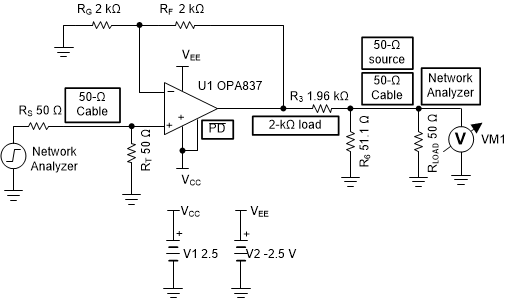ZHCSGP3D September 2017 – December 2018 OPA2837 , OPA837
PRODUCTION DATA.
- 1 特性
- 2 应用
- 3 说明
- 4 修订历史记录
- 5 Pin Configuration and Functions
-
6 Specifications
- 6.1 Absolute Maximum Ratings
- 6.2 ESD Ratings
- 6.3 Recommended Operating Conditions
- 6.4 Thermal Information: OPA837
- 6.5 Thermal Information: OPA2837
- 6.6 Electrical Characteristics: VS = 5 V
- 6.7 Electrical Characteristics: VS = 3 V
- 6.8 Typical Characteristics: VS = 5.0 V
- 6.9 Typical Characteristics: VS = 3.0 V
- 6.10 Typical Characteristics: ±2.5-V to ±1.5-V Split Supply
- 7 Detailed Description
-
8 Application and Implementation
- 8.1
Application Information
- 8.1.1 Noninverting Amplifier
- 8.1.2 Inverting Amplifier
- 8.1.3 Output DC Error Calculations
- 8.1.4 Output Noise Calculations
- 8.1.5 Instrumentation Amplifier
- 8.1.6 Attenuators
- 8.1.7 Differential to Single-Ended Amplifier
- 8.1.8 Differential-to-Differential Amplifier
- 8.1.9 Pulse Application With Single-Supply Circuit
- 8.1.10 ADC Driver Performance
- 8.2 Typical Applications
- 8.1
Application Information
- 9 Power Supply Recommendations
- 10Layout
- 11器件和文档支持
- 12机械、封装和可订购信息
8.1.1 Noninverting Amplifier
The OPAx837 can be used as a noninverting amplifier with a signal input to the noninverting input, VIN+. A basic block diagram of the circuit is illustrated in Figure 62. VREF is often ground when split supplies are used.
Calculate the amplifier output according to Equation 1 if VIN = VREF + VSIG.

The signal gain of the circuit is set by Equation 2, and VREF provides a reference around which the input and output signals swing. Output signals are in-phase with the input signals within the flat portion of the frequency response. For a high-speed, low-noise device such as the OPAx837, the values selected for RF (and RG for the desired gain) can strongly influence the operation of the circuit. For the characteristic curves, the noninverting circuit of Figure 74 shows the test configuration set for a gain of 2 V/V. Table 2 lists the recommended resistor values over gain.

Table 2 lists the recommended resistor values from target gains of 1 V/V to 10 V/V where standard E96 values are shown. This table controls the RF and RG values to set the resistor noise contribution at approximately 50% of the total output noise power. These values increase the spot noise at the output over what the op amp voltage noise produces by 41%. Lower values reduce the output noise of any design at the cost of more power in the feedback circuit. Using the TINA model and simulation tool shows the impact of different resistor value choices on response shape and noise.
Table 2. Noninverting Recommended Resistor Values
| TARGET GAIN (V/V) | RF (Ω) | RG (Ω) | ACTUAL GAIN (V/V) | GAIN (dB) |
|---|---|---|---|---|
| 1 | 0 | Open | 1.00 | 0.00 |
| 1.5 | 1190 | 2370 | 1.50 | 3.53 |
| 2 | 2000 | 2000 | 2.00 | 6.02 |
| 3 | 2260 | 1130 | 3.00 | 9.54 |
| 4 | 2370 | 787 | 4.01 | 12.07 |
| 5 | 2490 | 619 | 5.02 | 14.02 |
| 6 | 2550 | 511 | 5.99 | 15.55 |
| 7 | 2610 | 432 | 7.04 | 16.95 |
| 8 | 2670 | 383 | 7.97 | 18.03 |
| 9 | 2670 | 332 | 9.04 | 19.13 |
| 10 | 2670 | 294 | 10.08 | 20.07 |
